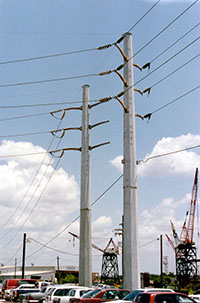Hot-Dip Galvanized Distribution Poles Steeling Power
Hot-dip galvanized steel has been used in the electric utility market since the advent of high voltage lines. Whether in a generation facility, substation, lattice tower, or renewable energy components, galvanized steel has been a backbone of North America’s power market, providing reliable, durable protection to components. However, one area of the power market hot-dip galvanized steel has rarely impacted is distribution poles. When considering the total expenditures by electric utilities for transmission and distribution poles, steel poles account for approximately 50-55%. This begs the question, why is so little steel used in distribution poles?

The simple answer is initial cost. On an initial cost basis, steel poles are typically more expensive than wood poles under 50 feet, and most distribution poles in North America are 40-45 feet; whereas transmission poles are often larger where steel is more cost competitive initially. Initial cost tends to drive many specification decisions not only in the electric utility market, but in the construction market as a whole. However as the mantel for sustainable development continues to beat louder, life-cycle cost – economic and environmental impact – are being given more consideration. Having said that, steel poles, particularly those treated with hot-dip galvanizing, have been shown to save 10-20% over the life-cycle when compared to wood poles. Developing the built environment to not only sustain but improve the quality of life for future generations requires such responsible, forward thinking.
In the lens of sustainability, life-cycle cost savings is only one advantage hot-dip galvanized steel distribution poles have over wood poles. Though wood is a natural product, chemical treatments must be applied to the wood poles to provide longevity. Many of these chemicals have negative environmental impacts – emitting harmful toxins into the air, soil, or ground water. Pentachlorophenol, a common wood pole treatment in North America, was recently identified as a persistent organic pollutant (POP) and a global, technical committee (Persistent Organic Pollutant Review Committee – POPRC) has recommended it be listed in Annex A of the Stockholm Convention. Listing in Annex A means the use of the chemical should be permanently banned. A final decision on the listing of pentachlorophenol will be made in May 2015.
Hot-dip galvanized steel distribution poles were highlighted by the POPRC as a potential, viable alternative to pentachlorophenol treated wood poles. Because galvanized steel is produced in a manufacturing process, it is easy to forget it is also a natural product. Both iron ore (steel) and zinc are found in the Earth’s crust, and in fact, they are the 4th and 24th most abundant elements respectively. In addition to being readily available, both steel and zinc are infinitely recyclable without the loss of properties. In other words, steel and zinc can be multi-cycled and used again, rather than being down-cycled as many recycled products are – creating a truly infinitely renewable building material.
In addition to recyclability, galvanized steel poles do not emit harmful toxins into the environment when in use. As galvanized steel weathers, the zinc surface changes to form zinc oxide, zinc hydroxide, and zinc carbonate. These byproducts are already naturally found in water, soil, and the air. In fact, zinc is essential to all life from humans to the smallest microorganisms. Unlike wood poles, and many other building products and coatings, hot-dip galvanizing’s energy inputs and emission outputs are isolated in the production phase, because no maintenance (for 75+ years) is required during use in atmospheric exposure. Therefore, any environmental impact from producing the poles can be distributed over the decades of maintenance-free life before 100% recyclability at the end-of-life. All of these factors create a net positive environmental effect over wood poles.
Beyond environmental and economic savings throughout the life of the pole, galvanized steel distribution poles can also provide a number of other advantages such as: strengthening the line, lighter weight which leads to lower shipping and installation costs, less damage during catastrophic events (fire, wind, etc.), and more. There are a number of resources available to learn about the positive impact of steel distribution poles as well as specifying and installing steel poles in existing wood lines through the Steel Market Development Institute (SMDI).
Construction spending in the electric utility market has often been primarily focused on the development of generation sources. However, as the transmission and distribution grids continue to age, it is projected North America will spend millions of dollars on the power lines in the next five years. With the tenets of sustainability in mind, and a potential ban on a common wood pole treatment in the works, it seems now is the time to consider hot-dip galvanized distribution poles as a viable, if not better, alternative for the power market.

